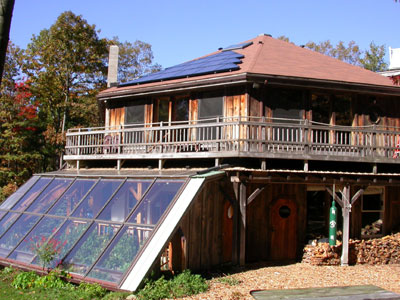
My interest in communes was sparked by reading Jennifer Gilbert’s and Chuck Light’s MFH grant proposal for their documentary about Total Loss Farm in Guilford, VT and the Montague Farm in Montague, MA. Right away I found the intentional communities website and was surprised to see a long list of communities—active and forming–in MA (51 as of this writing). I found a dozen in Western MA. I began my quest for knowledge by reading their websites, visiting and photographing the communities and speaking with members and would-be founders.
Intentional communities, the contemporary parlance for communes or commune-like groups, represent a spectrum of structured living arrangements: from basic co-housing groups formed on resource-sharing and ecological principles, such as Rocky Hill Cohousing in Florence and Pine Street in Amherst, to eco-villages comprised of members who also share a spiritual commitment, like the Sirius Community in Shutesbury and the Nehemiah Community in Springfield. Massachusetts is home to a range of religiously oriented groups that are Christian, Jewish, and Buddhist. Several MA intentional communities with a spiritual component are ecumenical in nature and accept members of diverse faiths. The shared spiritual mission of these communities generally focuses on social justice issues and sustainable lifestyles.
I decided to do my best to visit communities that were representative of the variants I had discovered. Beginning in October I visited: Healing Grace Sanctuary in Shelburne Falls (now a protected land-trust of 70 acres; the truly amazing owner has dreams of forming an intentional community and nature education center), Sirius Community in Shutesbury (a genuine 90% off-grid eco-village and meditation sanctuary that’s been in operation for 30years), Laughing Dog Farm in Gill (a CSA on the property of the former Renaissance Community; the owners indicate on their website that they seek another family or two to move to the property and help develop its agricultural potential), Rocky Hill Cohousing in Florence, and the Nehemiah Community in Springfield (the only urban community on the W. MA list).
I’ve been so flooded by images and impressions that, I confess, I hardly know where to start or how to make sense of it all. I’ve hit on a topic and a reality that is infinite. Since recording a full account of each visit would make an impossibly long blog entry, let me do my best to distill some of the needs and desires I see these communities fulfilling:
- Living with others in a contemplative, cooperative way, utilizing consensus decision-making
- Minimizing environmental impact
- Developing sustainable resources for the larger community (i.e. CSA farm shares, grease-car fueling stations, renewable energy)
- Sharing resources like time, tools and skills
- Planning for aging
- Administering social and racial justice work (The Nehemiah Community is active in this regard in Springfield, and Sirius hosts sleep-away retreats for inner city youth)
- Creating a disciplined lifestyle that subverts the US addiction to ease and speed
- Being a living example of peace by lessening or eliminating reliance on petroleum products, corporations, and agribusiness
I witnessed the concrete manifestations of these bullet points. It’s happening. So, to refer to Jennifer Gilbert’s suggestion that the experiences of the 60s communes just won’t become history or be subjected to scholarly analysis, I will assert that the communes of the sixties and the intentional communities of today are part of a continuum. There have been some stalled efforts or transformations—Total Loss Farm and the Renaissance Community are no longer communes, although the folks who were members back in the day still comprise communities (communities that are no longer open to anyone who hitchhikes to their neck of the woods, perhaps). In the sixties, the term for going back to the land to start fresh in an unspoiled Eden was “dropping out.”
to Jennifer Gilbert’s suggestion that the experiences of the 60s communes just won’t become history or be subjected to scholarly analysis, I will assert that the communes of the sixties and the intentional communities of today are part of a continuum. There have been some stalled efforts or transformations—Total Loss Farm and the Renaissance Community are no longer communes, although the folks who were members back in the day still comprise communities (communities that are no longer open to anyone who hitchhikes to their neck of the woods, perhaps). In the sixties, the term for going back to the land to start fresh in an unspoiled Eden was “dropping out.”
What I see emerging today, reverses that trend and seeks to apply lofty principles of living where they are needed but infrequently envisioned: in urban landscapes. I’m referring to intentional communities in urban settings: urban eco-villages. Most of us won’t have the luxury of buying—dirt cheap—50 acres of pristine farmland with a house that can shelter all our friends. Most of us won’t have the luxury of living without day-jobs. But we might all be capable of envisioning where we already live as an intentional community, and finding ways to share resources with friends and neighbors and fellow-residents of our towns and cities. What I’m asking myself now is: How could my block be an intentional community? How could my city government function more as an intentional community? What is my role in that transformation?
–Hayley Wood, Program Officer, Massachusetts Foundation for the Humanities


